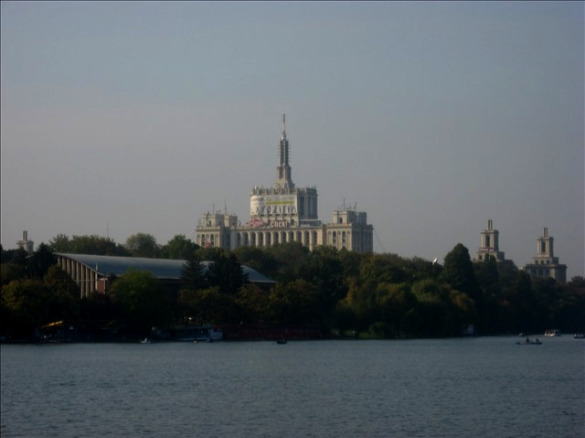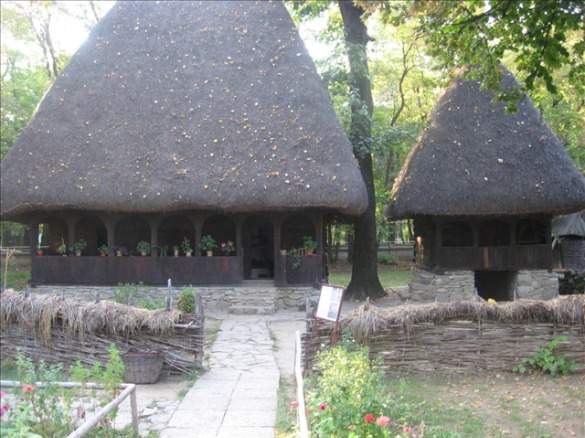Since I was kid, I have always been curious about exploring the things that rational people tell you to stay away from. On my second visit to Romania, my curiosity to see the capital city grew largely because everyone advised me against it. I will not deny that there are more scenic and culturally interesting places to visit in the country but I always feel that you have to visit the capital before you can say you have really seen a nation. I was convinced there had to be more to Bucharest than “concrete and beggars” which was the way it was described by my friends. Since no one else would come, I decided to go alone and took the train, which runs from Brasov to the capital.
Everyone told me that the train would make the Darjeeling railway look like the Shinkansen so I was pleasantly surprised when a clean looking, relatively fast train looking not unlike the monorail at EPCOT pulled into the station. I hopped on board and spent the best part of the next couple of hours curiously watching local gypsies in the villages we passed through as they hauled logs and vegetables on horse drawn carts from house to house without worrying about 401k balances or the underlying credit default swaps and sub prime mortgages that might threaten their nest eggs. The world recession is not as all encompassing as we sometimes imagine and you cannot be truly affected by a recession if you have not had any growth beyond the carrots in your yard to begin with. The train quickly pulled us into the twenty first century and before long we pulled into Bucaresti-Nord, the run down looking station that is the cities main rail hub.
I am usually a meticulous planner but this time I was unprepared and I did not even know Bucharest had a Metro system until I got off the train and noticed a blue sign saying “M” at the end of the concourse. I decided to wing it and bought a ticket that purportedly would be good all day. Without a clue as to where it would take me I decided to get on the M3 line because the yellow circular map of its route reminded me of the circle line at home in London. There were certain places I knew of in Bucharest from seeing them on the news in 1989 when Ceaucescu was deposed and foremost among them was the Palatul Parlamentului (Parliament Palace) which is by volume the third largest building in the world.
I had no idea where to find it but using the logic that such an important place would probably be in the middle of town I decided to exit at the station that on the map looked pretty much in the center, the Piata Unirii station. I knew that I was going to have a good day when I ascended the stairs and there was the palace sitting at the end of almost endlessly long boulevard. You only truly appreciate the sheer vastness of the place when you try to fit it all in a single camera shot and then realize that it is still a good 20-minute walk away. I was slightly disappointed on arriving to be told by the solitary security guard that the palace was closed on the weekend.
I set off back to the Metro station and this time took the M2 blue line because it looked liked the Victoria line in London and in keeping with that thought, I exited at the stop for Piata Victoriei. I am not a linguist but I was able to deduce that the name of the location translated as Victory Square. I left the crowded, yet surprisingly clean underground station, and stepped out in front of an array of concrete giants. The square was surrounded by enough cement to hide a million mobsters victims but having already filled my camera with snaps of the biggest communist era monstrosity of them all I decided to take a stroll and set off past the Government building wondering what else the city would have too offer.
After a brisk 10 minute stroll I came across Muzeul Taranului (Peasants Museum) The admittance fee was only a couple of dollars and it was well worth the cost to visit the museum which itself was a throw back to the pre-tourism era. It was set up like one of those tiny and barely funded “museums” you get at the bottom of stairwells in lighthouses. The strategy of the museum staff seemed to be trying to pack as many exhibits hap-hazardly into an unsuitably small space as they could. The lack of organization gave the whole place an innocent charm. There were rooms full of life sized costumed polystyrene mannequins some of which had poorly drawn eyes and moustaches but who were nevertheless eerily life like. I probably would have spent longer if I had a guide and were I planning to stay in the city past dark but with time ticking away I decided it was time to move on.
I started to walk along Sos Kiseleff, which like so many of Bucharest’s many avenues is larger than it appears to be. The building of interest down this boulevard is the Arcul de Triumf. I wondered if this was someone’s idea of trying to milk the notion that Bucharest is the “Paris of the East”. Based on the mightily impressive but not exactly eye pleasing buildings I had seen thus far I felt that a more appropriate description of the city would be “Pyongyang of the West.” The Arch was built but in 1935 to replace an original made of wood that was erected as a monument to soldiers who died in World War I. It is an impressive spectacle even if it is a rip off of the French version, which I suppose was itself a knock off of Constantine’s version 1500 years before and now that I think about it even he copied Titus’ one from 82AD. Perhaps I was a little hasty in knocking the Romanians for lacking originality, unlike the French, at least they can claim direct lineage through their country’s very name to the original arch builders!
Sadly, like the palace, the Arch was closed to visitors while I was there but normally one can go inside and get some great snap shots from the roof. One place I did get a snap shot of nearby, that I thought I was not going to live to regret was the Russian Embassy. I just thought it looked like quite a fancy looking building but no sooner had my flash gone off then I was security men waving guns in my direction surrounded me. Evidently, in the post 9/11 world it is not a smart move to photograph government buildings. Luckily, the one guard who spoke English only erased the offending picture and did not wipe the memory card clean.
Lesson learnt I made my way past the arch and towards the 187 hectare Herastrau Park. The first part of the park is occupied by the open-air village museum, which features 300 buildings that were relocated to the park from all over the country starting in 1925. The aim of the museum was to give visitors to Bucharest a concise record of the many and varied styles of architecture that are to be found across the nation. The most modest of these structures form a stark contrast with the obscenely lavish Piles castle near Brasov.
When you compare the opulence of the ruling classes a hundred years ago with the squalid beehive like structures that the poorest of society lived in it is easier to understand how a socialist dictator like Ceaucescu was initially able to win public support. If some rabble-rousers had shown up at your thatch offering you an end to inequity it is hard to imagine the average peasant saying “No thanks I’m going stay here in my beehive and make some more honey.” The irony is though that the modest habitats on display here were replaced by equally inept but much less eye-pleasing concrete rabbit hutches that are now crumbling all over the nation whilst the new ruler turned out to be more outlandish in his personal spending than the worst aristocrats in history.
I spent about an hour looking at the many and varied structures and I would say that this is a must see for any visitor to the city. The park itself, like most things in Bucharest, is enormous and towering over the northern end of the park is the mighty Casa Presei Libere (House of the Free Press) which is virtually identical to the much more famous Palace of Science and Culture in Warsaw.
The regimes that ran eastern Europe for fifty years may not have been concerned with aesthetically pleasing buildings but they certainly knew how to take your breath away with awesome construction projects. I was gazing at the reflection of the Free Press building in Hersatrau lake when I realized that my train back to Pitesti would be leaving in less than 2 hours. When you have been wandering all day in a strange city and suddenly find yourself in the center of a park so vast it stretches in every direction as far as the eye can see, time can go by pretty quickly.
I am not sure if it was because the locals lived up to metropolitan stereotypes and were trying to be unhelpful or if it was due to my poor Romanian but my attempts to follow directions from various locals were disastrous and it took me over an hour to find my way out of the park. I made it to the station with about 10 minutes to spare after a fairly impressive 2km run through the crowded streets. A brief tussle with the world’s least subtle pickpocket was my last act in the capital before I hopped back onto the squeaky-clean train that had brought me there. I wish I had been able to stay for longer because the city had much more to offer than I had been lead to believe.
Having seen the city though I can see why people who grew up as kids having to contend with rationing and power outages may not have the fondest of views of the place that was largely demolished and then extravagantly rebuilt by a modern day Nero. There are few remnants of the pre-war Parisian style that used to attract the artisans but there is still so much to see. It feels safe, it is clean and it is not spoilt by over commercialization and the sound of raucous northern Europeans having bachelor parties. Less expensive than Budapest, more interesting than Bratislava and far more accessible than Pyongyang, this is one place I would very much like to return to.



